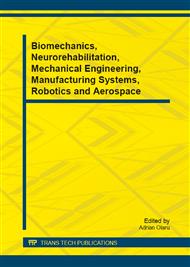p.45
p.57
p.63
p.68
p.74
p.80
p.85
p.90
p.99
Study of Straight and Oblique Mandible Fracture Behavior in the Chin Section
Abstract:
. This work is focused on stress - strain analysis of a mandible fracture behavior in the case of straight and oblique fracture. For this problem the computational modelling was chosen with using finite element method. Mandible was created based on the 3D scanning and CT images. Using these procedures a STL model of mandible with cortical and cancellous bone tissue was created. A volume model of lower jaw with applied reconstruction plate was created in CAD software. Fracture in the chin region was modelled directly in the program ANSYS. The cancellous bone tissue is modeled with different mechanical properties, which corresponds to the varying quality of this tissue. An assessment of differences in the behavior of straight and oblique fracture is presented in this work.
Info:
Periodical:
Pages:
74-79
Citation:
Online since:
December 2012
Price:
Сopyright:
© 2013 Trans Tech Publications Ltd. All Rights Reserved
Share:
Citation:


